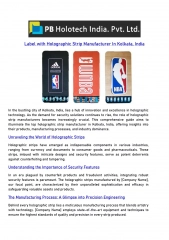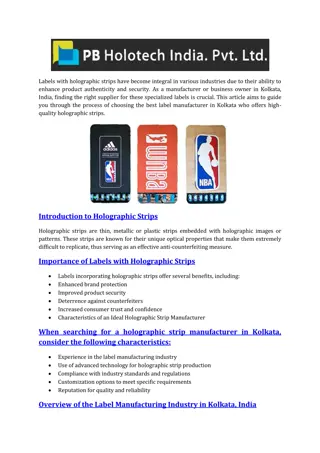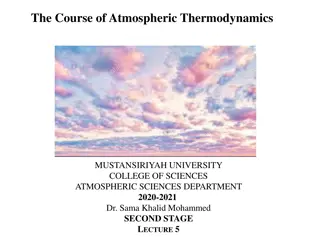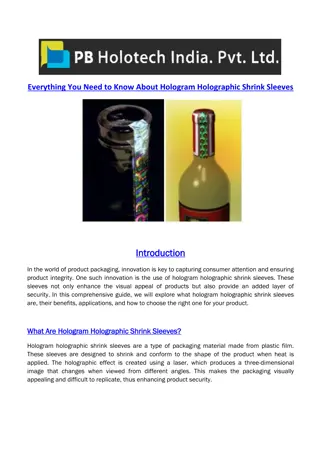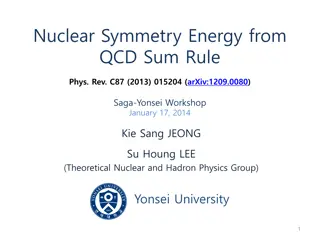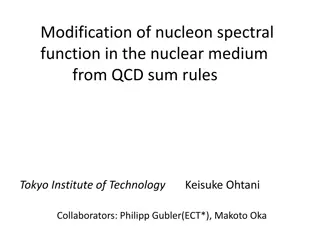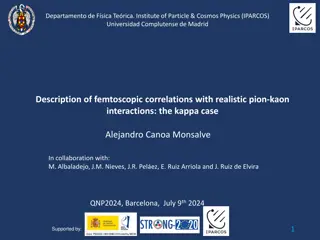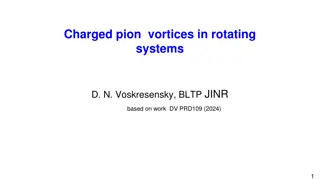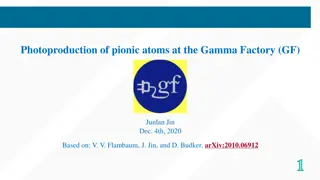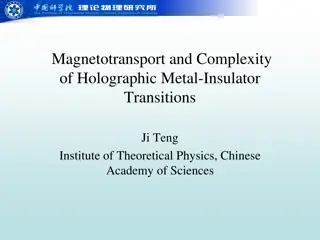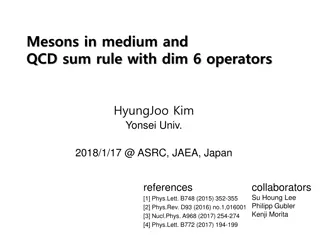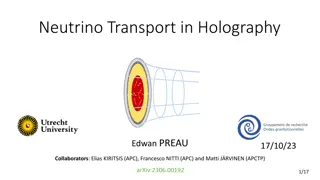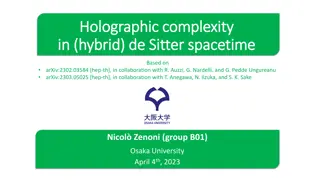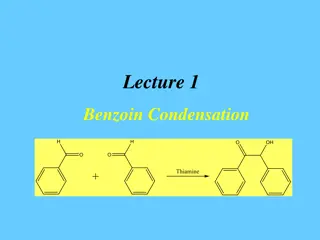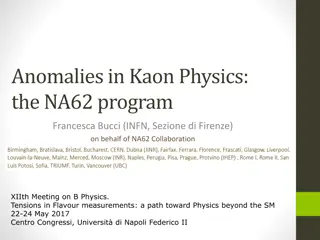
Understanding Gauge/Gravity Duality in QCD Effective Field Theories
Explore the fascinating world of Gauge/Gravity Duality in Quantum Chromodynamics (QCD) through effective field theories and models. Delve into the concepts of top-down versus bottom-up approaches, holographic QCD, and the implications for hadron spectra, chiral symmetry breaking, and more.
Download Presentation

Please find below an Image/Link to download the presentation.
The content on the website is provided AS IS for your information and personal use only. It may not be sold, licensed, or shared on other websites without obtaining consent from the author. If you encounter any issues during the download, it is possible that the publisher has removed the file from their server.
You are allowed to download the files provided on this website for personal or commercial use, subject to the condition that they are used lawfully. All files are the property of their respective owners.
The content on the website is provided AS IS for your information and personal use only. It may not be sold, licensed, or shared on other websites without obtaining consent from the author.
E N D
Presentation Transcript
???? ??? ???? ???????????? ???? ??????????? ??? Yidian Chen School of Physics, Hangzhou Normal University Based on arXiv: 2408.17080, 2505.xxxxx Collaborators: Mingshan Ding, Danning Li, Kazem Bitaghsir Fadafan, and Mei Huang Apr. 27, 2024 1
Outline I. Introduction II. Holographic Model and Pion Condensation III. Pionic Equation of State and Pion Star IV. Kaon Condensation V. Conclusion and discussion 2
Isospin The relevant QCD degrees of freedom at low energies are pions Chiral perturbation theory (T=0) D.T. Son, M. Stephanov, PRL 2001 vacuum at pion BEC at (2nd order phase transition) Lattice QCD Brandt, Endrodi, Schmalzbauer, PRD2018 no sign problem at finite physical quark masses achieve consistent with ?PT predictions 4
Pion Condensation Vovchenko et al., PRL126, 012701 (2021) Mannarelli, Particles (2019) 5
Strangeness and Kaon Condensation For three flavor, we can introduce the baryon, isospin, and strangeness chemical potentials ??, ??, and ?? 6 Andersen et al., PRD111, 034017 (2025)
Gauge/Gravity duality AdS/CFT correspondence relates gravity theories on anti-de Sitter spacetimes (AdS) to conformal field theories General Gauge/Gravity duality 7
QCD Effective field Effective field theories and theories and models models FRG FRG DSE DSE QM, NJL, SM, QM, NJL, SM, HLS, HLS, CHPT, NRQCD, CHPT, NRQCD, color flux tube, color flux tube, Dual Dual superconductor superconductor 8
Top-down vs Bottom-up Top-down based on string theory and D-brane D3-D7, D4-D6, D4-D8, STU model Bottom-up from symmetry of QCD hard-wall, soft-wall, Gubser model, improved holographic QCD, VQCD, dynamical holographic QCD 1) 5D effective action 2) IR cutoff or dilaton to realize confinement Hadron spectra, chiral symmetry breaking & linear confinement, phase transitions, equation of state, transport properties 9
Holographic dictionary Boundary QFT Gravity Local operator Field conformal dimension , p-form field ? Strongly coupled Weakly coupled semi-classical 10
Soft-Wall Model Karch et al., Phys.Rev.D (2006) 5D action To realize the linear Regge trajectory ConformalAdS5 Schroedinger-like equation 11
Chiral Condensation Chelabi et al., Phys.Rev.D (2016) Chelabi et al., JHEP (2016) 5D action 12
II. Holographic Model and Pion Condensation 13
Model Y. Chen, M. Ding, K. Bitaghsir Fadafan, D. Li and M. Huang, arXiv: 2408.17080 The holographic QCD model with Nf = 2 is constructed from SU(2)L SU(2)R SU(2)V SU(2)A flavor symmetry. The probe action is given as The vacuum of scalar corresponds to sigma condensate and pion condensate can be given as ? =1 ?0+ 2 3 ? = ?? ???2, with isospin chemical potential and isospin ???. The nonzero gauge field of model is ?0 density. And the background metric is AdS-black hole we have considered two possible forms of the five-dimensional mass squared as follows: ??= 70.7 ??? ??= 92.4 ??? 14
Model Y. Chen, M. Ding, K. Bitaghsir Fadafan, D. Li and M. Huang, arXiv: 2408.17080 The equations of motion of the holographic model are obtained as For the fields, the expansions are 15
Condensation Y. Chen, M. Ding, K. Bitaghsir Fadafan, D. Li and M. Huang, arXiv: 2408.17080 16
Condensation Y. Chen, M. Ding, K. Bitaghsir Fadafan, D. Li and M. Huang, arXiv: 2408.17080 According to PT, the expressions for isospin density and axial-vector condensation can be simplified to 17
III. Pionic Equation of State and Pion Star 18
Thermodynamics Y. Chen, M. Ding, K. Bitaghsir Fadafan, D. Li and M. Huang, arXiv: 2408.17080 At zero temperature, the pionic pressure p and energy density can be given by thermodynamic relations 19
Speed of Sound Y. Chen, M. Ding, K. Bitaghsir Fadafan, D. Li and M. Huang, arXiv: 2408.17080 The square of the speed of sound and adiabatic index is given as are defined as 20
Pion Star Y. Chen, M. Ding, K. Bitaghsir Fadafan, D. Li and M. Huang, arXiv: 2408.17080 The form of the TOV equations are as follow The dimensionless tidal deformability where 21
Pion Star Y. Chen, M. Ding, K. Bitaghsir Fadafan, D. Li and M. Huang, arXiv: 2408.17080 22
Model The holographic QCD model with Nf = 3 is given as 24 Fang et al., PRD100, 054008 (2019)
Model Y. Chen, M. Ding, K. Bitaghsir Fadafan, D. Li, and M. Huang, arXiv: 2505.xxxxx The holographic QCD model with Nf = 3 is given as 3 and ?0 8 The nonzero vector fields of model are ?0 The vacuum of scalar can be given as 25
Model Y. Chen, M. Ding, K. Bitaghsir Fadafan, D. Li, and M. Huang, arXiv: 2505.xxxxx 26
Model Y. Chen, M. Ding, K. Bitaghsir Fadafan, D. Li, and M. Huang, arXiv: 2505.xxxxx 27
Summary 1) The results from the holographic models show good agreement with lattice QCD in terms of isospin density, axial-vector condensation, EoS, phase diagram and normalized trace anomaly. However, discrepancies were found in the calculations of the sound speed and adiabatic index at zero temperature. 2) Further analysis shows that the results from the holographic models are very similar to those from PT. 3) Our calculations revealed that the typical radius of a pion star is approximately 100 kilometers, with a mass around 10? . The tidal deformability, , ranges from 10 to 108. 29
Thanks 30

